Tonestus
Bot. Gaz. 37: 262. 1904.
| Taxon | Illustrator ⠉ | |
|---|---|---|
 | Lorandersonia pulchella Tonestus lyallii Acamptopappus sphaerocephalus var. sphaerocephalus | John Myers Yevonn Wilson-Ramsey Barbara Alongi |
Perennials, 1–21 cm (cespitose, sometimes mat-forming; taproots usually ± well developed, poorly so in T. lyallii, caudices branched or rhizomes short). Stems erect, simple, hairy and/or ± densely stipitate-glandular. Leaves basal and cauline; alternate; petiolate (basal and cauline) or sessile (cauline); basal blades 1-nerved, 3-nerved, or 5-nerved, linear to broadly spatulate, cauline progressively reduced distally (bases ± clasping), margins entire, coarsely and irregularly serrate, dentate, or lobed, sometimes ciliate, faces glabrous or scabrous, eglandular or stipitate-glandular. Heads radiate or discoid, in usually racemiform, sometimes corymbiform arrays. Involucres narrowly to broadly campanulate, (5–28 ×) 6–20 mm. Phyllaries 16–34 (–44) in 3–4 (–5) series, usually green, sometimes anthocyanic, 1-nerved or weakly 3–5-nerved (flat), equal to unequal, sometimes chartaceous proximally, margins ciliolate or eciliate, faces often stipitate-glandular at least distally; outer ovate, oblong, or broadly lanceolate, often foliaceous (apices rounded, obtuse, or acute); inner linear to narrowly oblong, margins scarious, fimbriate (apices acute to acuminate, sometimes reflexed), faces sometimes stipitate-glandular distally. Receptacles convex, pitted, epaleate. Ray-florets 0, or 10–23 (–35), pistillate, fertile; corollas yellow (tubes sparsely hairy, laminae narrowly elliptic, coiling at maturity). Disc-florets 13–66, bisexual, fertile; corollas yellow, tubes (glabrous or sparsely hairy) shorter than narrowly funnelform to ± ampliate throats, lobes 5, erect or spreading, deltate to broadly lanceolate; style-branch appendages subulate to lanceolate. Cypselae cylindric to linear, terete, 4–12-nerved, faces glabrous or villous; pappi persistent, of 30–60 whitish, ± equal, brittle or flexible, fine, barbellate, apically attenuate bristles in 1 series (± equaling corollas). x = 9.
Distribution
w North America
Discussion
Species 4 (4 in the flora).
Recent work by L. Brouillet et al. (2004) and R. P. Roberts and L. E. Urbatsch (2004) has refined our understanding of the affinities of taxa included by G. L. Nesom and D. R. Morgan (1990) in Tonestus, some of which are now referred to Eurybia, Lorandersonia, or Toiyabea. In spite of these revisions, Tonestus appears to comprise at least three distinct elements. Two species primarily of the Rocky Mountains and ranges of the Pacific Northwest, T. lyallii and T. pygmaeus, resemble one another morphologically; molecular systematic studies by Roberts and Urbatsch suggested that these may be more closely related to different elements of the Solidagininae than they are to each other or to the remainder of the taxa included here in Tonestus. Likewise, while morphologic evidence indicates that T. eximius and T. peirsonii are closely related, the work of Roberts and Urbatsch placed the decaploid T. peirsonii in a clade with members of Lorandersonia wherein it is treated here; T. eximius is placed within a largely unresolved clade of the Solidagininae. Tonestus graniticus is included here mostly as a matter of convenience. It bears only superficial resemblance to other taxa included in the genus, differing in habit, array of heads, involucre, and hair type. The placement of this species within Solidagininae remains uncertain, although the work of Roberts and Urbatsch suggested that it may be related to Chrysothamnus. The treatment presented here must be considered tentative, at best. Tonestus pygmaeus is the nomenclatural type of the genus; further refinement of the taxonomy of this difficult group may require nomenclatural innovations.
Selected References
None.
Lower Taxa
Key
| 1 | Leaf margins entire; Rocky Mountains, ranges of the Pacific Northwest, rarely ranges of n California and nw Nevada | > 2 |
| 1 | Leaf margins serrate, dentate, or lobed; s Great Basin or Sierra Nevada ranges | > 3 |
| 2 | Plants densely stipitate-glandular, otherwise glabrous; outer phyllaries oblong to broadly lanceolate, apices acute; cypselae glabrous or sparsely hairy distally | Tonestus lyallii |
| 2 | Plants eglandular or sparsely stipitate-glandular, non-glandular hairs present at least as cilia on leaves and phyllaries; outer phyllaries ovate to oblong, apices obtuse or rounded; cypselae villous | Tonestus pygmaeus |
| 3 | Leaves glabrous; heads radiate, 1 or 2(–4); involucres (9–)12–25(–28) × (5–)8–20 mm; ec California, Washoe County, Nevada | Tonestus eximius |
| 3 | Leaves scabrous; heads discoid, (1–)3–7(–11); involucres 5–9 × 6–10 mm; Esmeralda County, Nevada | Tonestus graniticus |
"[" is not declared as a valid unit of measurement for this property."]" is not declared as a valid unit of measurement for this property.